Rishyasringa
Rishyasringa (Sanskrit: ऋष्यशृंग; IAST: Ṛṣyaśṛṅga) was a boy born with the horns of a deer in Hindu religious history who became a seer and was seduced by a king's daughter, which had various results according to the variations in the story.
| Rishyasringa | |
|---|---|
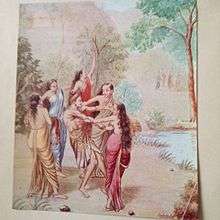 Ṛṣyaśṛṅga lured into aṅgadēśa by dancing girls | |
| In-universe information | |
| Family | Vibhandaka (father) Urvashi (mother) |
| Spouse | Shanta |
Hindu versions of the story
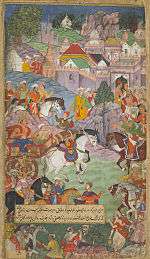
Rishyasringa was a boy born with the horns of a deer in Hindu religious history. His father was the Vibhandak Rishi, and his mother was a celestial paramour. According to another legend, he was believed to have been born of a doe and from the slight protrusion of his forehead.
According to legend, his father was seduced by the celestial danseuse Urvasi by order of Indra, the king of gods, who feared the yogic powers gained out of penance by the rishi could prove fatal to the very existence of heavenly world. The father was seduced and out of his relation with the danseuse was born Rishyasringa.

However, immediately after the child was born, Urvashi, after completing the duty she was sent for, left the young born child and her lover and made her way to the heavens. The incident left the father with extreme hatred towards women folk, and he raised the boy in a forest, isolated from society. He never saw any girls or women, and was not told of their existence. The tradition states that he was endowed with magical and miraculous powers.
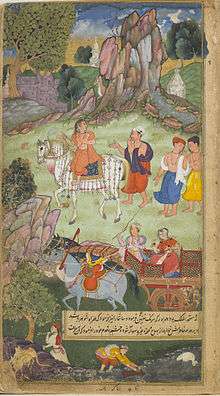
In the usual version of the story, at the time that the boy becomes a young man, the kingdom of Anga suffers from drought and famine. The king, King Romapada, is told that this can only be alleviated by a brahmin with the powers that come from observance of perfect chastity. The only such person is Rishyasringa. He has to be brought to the city, and be persuaded to carry out the necessary ceremonies. Despite his fear of the power and anger of the boy's father, the king sends young women to introduce the boy into normal society. This was successfully done by Vaishali, Rishyasringa uses his powers, the kingdom receives bountiful rains and Rishyasringa marries Shanta. Much of the story is taken up by accounts of the feelings of the young man as he becomes aware of women for the first time.
In another version of the story, the forest in which the boy is brought up is part of Anga. The boy's upbringing without knowledge of women is itself the cause of the troubles of the kingdom.
The story can be found in both the Ramayana and the Mahabharata. According to the Ramayana, Ekashringa was the chief priest when the king Dasharatha performed a yajna to beget progeny, and Rama, Bharata, and the twins Lakshmana and Shatrughna were born.
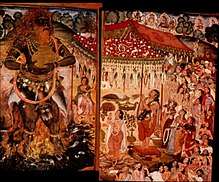
Buddhist versions of the story
Naḷinikā Jātaka
The Naḷinikā Jātaka (Jā 526) introduces a past life of the Buddha, a sage, living alone in the Himālayas. There is semen in the urine he passes, and a deer who happens to eat the grass in that place gets pregnant from it. A human boy named Isisiṅga (Pali) is later born to the deer and he is brought up in complete seclusion from mankind, and most importantly, from womankind.
The boy's ascetic power becomes so great that it disturbs the god Sakka, who causes a drought to occur in the country and blames it on the boy. He then convinces the King to send his daughter to seduce him and to break his power. The King and his daughter accept Sakka's reasoning and in good faith – and for the benefit of the country – agree to the plot.
The girl dresses up as an ascetic and while the father is away gathering roots and fruits in the forest, she manages to seduce the boy, who has never seen a woman before. Through their revelling, the boy does indeed lose his powers, after which the girl departs. When his father returns, the infatuated boy informs him of the girl, only to be instructed and rebuked by his father. He then repents for his actions.
Alambusā Jātaka
Jātaka 523, the Alambusā Jātaka, recounts a similar story. Sakka chooses a heavenly nymph to seduce the ascetic. The outcome is the same: the sage is seduced, repents and Sakka is thwarted. In response, he grants a boon to the seductress.
The story also appears in the Mahāvastu (Jones' translation pp. 139–147), but Ekaśr̥ṅga, as he is known here, is the Bodhisattva, and Nalinī is a past life of Yaśodharā. A major variation in this version of the story is Ekaśr̥ṅga's ignorance of his marriage to the girl. He succumbs to worldly responsibilities, eventually becoming king and fathering 32 children before retiring again to the forest and regaining his former powers.
Present day
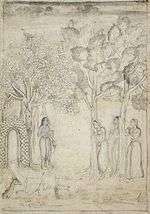
There is a temple of rishyashringa named 'Chehni fort' situated in Banjar tehsil of Distt. kullu Himachal pradesh.In Banjar valley Rishyashringa is called as "Shringa Rishi" by the locals. Idol of Shringa Rishi with goddess Shanta resides in the temple. This place is about 50 km from Kullu. Lord Shringa is the presiding deity of this secluded valley named Banjar. The descendants of Shanta and Rishyasringa are Brahmins in Rajasthan state known as Shringi/ Sukhwal Brahmins.
There is a sect of Sengar Rajputs who are called the only Rishivanshi rajputs who associate their lineage to Shring Rishi and Mata Shanta.
There is also a belief that sage Rishyashringa was from a place near Shringeri in Karnataka. There is an ancient big temple nearby which is believed to be the place where he lived before moving to Ayodhya.
References
- Dictionary of Hindu Lore and Legend (ISBN 0-500-51088-1) by Anna Dallapiccola
External links
- Shringirishi.org
- Translation of Bala Kanda in Rāmāyaṇa, Sarga 9 by Desiraju Hanumanta Rao
- Text and Translation of Naḷinikā Jātaka and its Commentary by Ānandajoti Bhikkhu
.jpg)